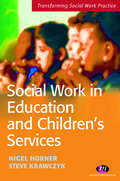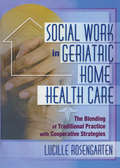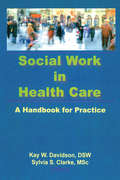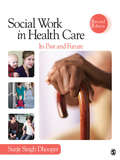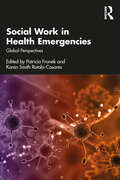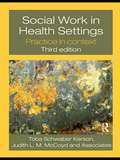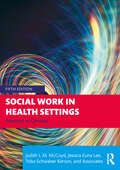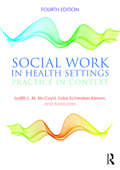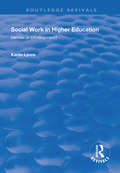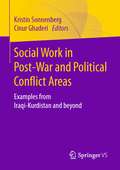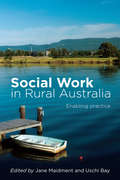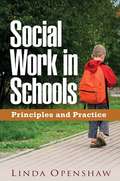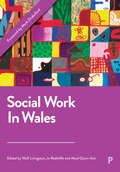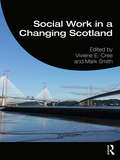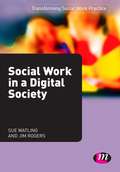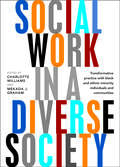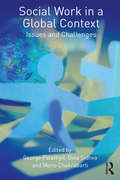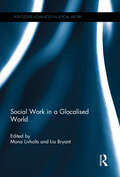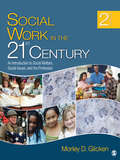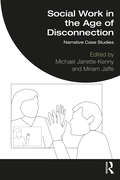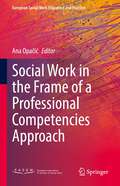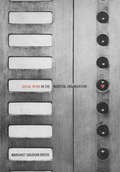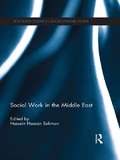- Table View
- List View
Social Work in Education and Children′s Services (Transforming Social Work Practice Series)
by Nigel Horner Steve KrawczykIn light of the profound changes confronting the Child Welfare landscape, social work practitioners are expected to understand both the current and anticipated inter-relationships between social work and education. A clear introduction to social work in an educational setting, this book supports students on the social work degree course and builds on the success of the Transforming Social Work Practice series, which is based on common learning principles.
Social Work in General Practice (National Institute Social Services Library)
by E. Matilda Goldberg June E. NeillIn the early 1970s general practitioners were well aware that they were being asked to deal not only with physical illness in their patients but also with the stresses relating to social and emotional problems. Increasingly often they were working together with health visitors and social workers in attempting to respond more effectively to these demands. Originally published in 1972, this study describes the attachment of a social worker to a group general medical practice in London, indicating why, for all social groups, the general practice is an appropriate point at which psychosocial problems may be identified and treated. The authors describe the nature and range of patients’ problems that come to light in the consulting room; how patients present their problems to the social worker; and the kind of help the social worker is able to offer. They explore the extent to which the general practice setting provides opportunities for preventive therapy and further describe how social work in general practice can most effectively be related to existing social services in the community, particularly to the reorganised personal social services. Their findings are supported throughout by illuminating case studies. The book also discusses the integration of the social worker into the general practice team, the problems that have to be solved and the mutual enlightenment that results. This emerges as an extremely encouraging and instructive experiment, which will immediately interest social service departments and social workers, doctors and nurses, both students and those in practice. The wide spectrum of social problems encountered and dealt with by the social worker in a general practice make it a particularly stimulating account.
Social Work in Geriatric Home Health Care: The Blending of Traditional Practice with Cooperative Strategies
by Lucille RosengartenExplore how community-based networks can effectively meet the needs and problems of sick, elderly people and their caregivers!Social Work in Geriatric Home Health Care: The Blending of Traditional Practice with Cooperative Strategies explores how social workers, aides, nurses, administrators, and policy makers can cooperatively work by maintaining appropriate health records in order to keep the elderly living at home. Based on the author’s twenty-five years of social work experience in geriatric home care case management, this book explores improved ways to organize home health care by use of cooperative strategies in order to assist older individuals in living independent lives at home. Complete with informative case studies and interviews, you will explore useful examples of geriatric social work practice through Concerned Home Managers for the Elderly, (COHME) a nonprofit, licensed home health care agency. Social Work in Geriatric Home Health Care examines many crucial geriatric care and case management issues of concern to geriatric social workers, including:offering meaningful and fulfilling work as a home health care aideproviding high-quality training and ongoing education for home care aidescreating a cooperative environment by encouraging staff, social workers, and nurses to share expertise with the case management coordinators who are responsible for placing the geriatric patient at home or in a special care facilityinvolving the client in the management of his or her own health carecreating concise, one-page reports for each home visit by using a “One-Sheet” to help you extract case assessments and plans for your geriatric client in a readily accessible formatdealing with state regulatory authorities and the general trend in home health care to place the elderly in nursing homespaying careful attention to financial and administrative problems within your organization while striving to remain true to your original mission of providing at-home careSocial Work in Geriatric Home Health Care will help you explore a different way of organizing home health care for the sick and elderly at a time when the percentage of people over sixty-five who will require care is rapidly increasing. This important book works to improve the case management of geriatric people and challenges home health care workers and legislators to become more progressive in their thinking about the direction in which geriatric health care should move at the turn of the century. With this vital book, you will gain insight into organized and cooperative methods of providing home health care for the elderly and find improved methods for managing your geriatric cases to give your clients optimum care.
Social Work in Health Care: A Handbook for Practice (Social Work In Health Care Ser. #Vol. 12, No. 3)
by Kay DavidsonHere is an outstanding reference book of major readings in the field of social work in health care. Practitioners, educators, researchers, and students can use this landmark two-part volume to review dominant themes and critical issues in today’s practice environment and to understand the evolution of current trends and emerging policies and programs. In this one desktop source book, hundreds of references relevant to the health care social work field are immediately accessible. Education, policy, practice, and research issues integral to social work’s expanding role in health care are the main focus, with each chapter highlighting a theme of enduring importance to the field. Other outstanding articles related to the chapter’s theme are cited in the appendix to each chapter which also includes a selected bibliography of suggested topical readings. Comprehensive new book filled with information vital to social workers in the health care field! Over 900 pages of scholarly articles by the foremost social work leaders in health care! 9 categories embrace the range of social work activity in the health care field! Exciting new ideas and practical suggestions for everyday dilemmas! Hundreds of references immediately accessible in one desktop source! Selected bibliography of topical headings provides sources for even more relevant articles! A MUST HAVE volume for instructors and students! Deepen your understanding of all aspects of social work practice in health care with this superb volume! Here is an outstanding reference book of major readings in the field of social work in health care. Practitioners, educators, researchers, and students can use this landmark two-part volume to review dominant themes and critical issues in today’s practice environment and to understand the evolution of current trends and emerging policies and programs. Social Work in Health Care makes hundreds of references relevant to the health care social work field immediately accessible in this one desktop source book. Education, policy, practice, and research issues integral to social work’s expanding role in health care are the main focus, with each chapter highlighting a theme of enduring importance to the field. Other outstanding articles related to the chapter’s theme are cited in the appendix to each chapter which also includes a selected bibliography of suggested topical readings. Find answers and ideas for everyday dilemmas in this all-inclusive, information-packed volume!Social workers practicing in the rapidly expanding health care field call upon a repertoire of skills to fulfill a variety of functions including direct patient care and contact with patients’families, education, and influencing organizational policies on their clients’behalf. The in-depth scholarship and the diversity of multiple approaches to health care social work, as presented in Social Work in Health Care, will have a strong impact on the field. Through the intertwining network of education, policy, practice, and research issues in the book, and professsional discussion of those topics, a beginning point exists from which social workers can develop principles to guide their social work activities in the medical and health fields.
Social Work in Health Care: Its Past and Future (2nd Edition)
by Surjit Singh DhooperSocial Work in Health Care: Its Past and Future gives social workers up-to-date, comprehensive information about the roles they can play and the skills they need in all aspects of health care. The book focuses on health care's four major domains: acute care, ambulatory care, illness prevention and health promotion, and long-term care. The author reviews the past and present of each of these fields, projects their major needs in the future, and suggests how social work can step in and help meet those needs. He presents practice theories, principles, approaches, models, and techniques appropriate for the many social work roles and responsibilities. The book concludes by describing general strategies social workers can use to succeed and thrive in health care settings.
Social Work in Health Emergencies: Global Perspectives
by Patricia FronekThis is the first comprehensive book that provides accessible, international knowledge for practitioners, students and academics about social work in health emergencies and spans fields of practice across world regions with particular reference to the COVID-19 pandemic. Divided into three sections: • Regional, Historical and Social Work Perspectives takes a journey through world regions during the first six months of the pandemic as it unfolded, explores the lessons found in the history of pandemics and situates public health social work practice in the values of the profession. Situating the diversity of challenges and opportunities in context, in turn, influences current and future social work practice. • Social Work Practice, Issues and Responses explores social work practice innovations and responses across eleven key practice fields. International authors feature social work responses during the COVID-19 health emergency from different regions of the world. • Preparing for the Future analyses broader concepts, innovations and the implications for future practices as social work enters a new era of service delivery. The 20 chapters explore the convergence of pandemic, politics and planet which is critiqued within a framework of the profession’s ethics and values of human dignity, human rights and social justice. Social work’s place in public health is firmly situated and built on the premise that the value social work brings to the table deserves recognition and should be documented to inform the development of the profession and future practice and how social work must carry lessons forward to prepare for the next pandemic. The book is relevant to a wide range of audiences, including practitioners, educators and students in social work, human services, international development and public health, as well as policy makers and researchers.
Social Work in Health Settings
by Judith L.M. McCoyd Toba Schwaber KersonThe most comprehensive book of its kind, Social Work in Health Settings presents a "practice in context" framework which is then applied in thirty-one casebook chapters, covering a great variety of health care settings from working with survivors of domestic violence through supporting people with HIV to services for military personnel. Reflecting the enormous changes in policy, health care delivery, insurance systems, and the diagnosis and treatment of many conditions, this third edition features all new case chapters. Each chapter considers the impact of dimensions of context including policy, technology and organization on the client situation and then explores the key practice decisions that structure the helping relationship: the definition of the client; determining goals, objectives and contract; meeting place; use of time; strategies and interventions; stance of the social worker; use of resources outside of the social worker/client relationship; reassessment and evaluation; and transfer or termination. This thought-provoking volume thoroughly integrates social work theory and practice, and provides an excellent opportunity for understanding particular techniques and interventions. In this era of managed care, downsizing, and moving away from hospital-based work, the approach taken in Social Work in Health Settings proves more salient than ever before.
Social Work in Health Settings: Practice in Context
by Toba Schwaber Kerson Judith L.M. McCoyd Jessica Euna LeeThis fully revised and expanded fifth edition of Social Work in Health Settings: Practice in Context maintains its use of the Practice-in-Context (PiC) decision-making framework to explore a wide range of social work services in healthcare settings. The PiC is updated in this edition to attend to social determinants of health and structural conditions. The PiC framework is applied in over 30 case chapters to reflect varied health and social care settings with multiple populations. Fully updated to reflect the landscape of healthcare provision in the US since the Affordable Care Act was reaffirmed in 2020, the cases are grounded by "primer" chapters to illustrate the necessary decisional and foundational skills for best practices in social work in health settings. The cases cover micro through macro level work with individuals, families, groups, and communities across the life course. The PiC framework helps maintain focus on each of the practice decisions a social worker must make when working with a variety of clients (including military veterans, refugees, LGBTQ+ clients). The ideal textbook for social work in healthcare and clinical social work classes, this thought-provoking volume thoroughly integrates social work theory and practice and provides an excellent opportunity for understanding particular techniques and interventions.
Social Work in Health Settings: Practice in Context
by Judith L.M. McCoyd Toba Schwaber KersonSocial Work in Health Settings: Practice in Context maintains its use of the Practice in Context (PiC) decision-making framework to explore a wide range of social work services in health care settings. The PIC framework is used to cover a broad range of social work practice sites, settings and populations over 30 case chapters. Fully updated to reflect the landscape of health care provision in the US since the Affordable Care Act was passed, the cases are grounded by 'primer' chapters to illustrate the necessary decisional and foundational skills for best practices in social work in health settings. The cases cover working with both individuals and groups of clients across the life course and the PiC framework helps maintain focus on each of the practice decisions a social worker must make when working with a variety of clients from military veterans to HIV positive children. The ideal textbook for social work in health care and clinical social work classes, this thought-provoking volume thoroughly integrates social work theory and practice, and provides an excellent opportunity for understanding particular techniques and interventions.
Social Work in Higher Education: Demise or Development? (Routledge Revivals)
by Karen LyonsFirst published in 1999, in the light of recent moves towards deprofessionalisation and instrumentalism, Karen Lyons has conducted extensive research into the challenges facing social work training as a higher education discipline. Here, these challenges are located in a discussion of wider changes in both higher education and the personal social services, and are also linked to debates about professional education and the nature of knowledge. The analysis is based on original data and includes reference to pedagogical and cultural factors, and to internal and external policies which might make social work viable or vulnerable in the higher education context. This multi-disciplinary perspective reflects a characteristic of social work study itself - a quality which might be seen as either problematic or as a strength. The book concludes that, while the future scale and form of the social work subject area lie partly outside the control of social work educators, they have a key role to play in the development of the discipline. This includes the promotion of research, which should underpin the creation of knowledge and inform professional practice in the changing field of personal social services.
Social Work in Post-War and Political Conflict Areas: Examples from Iraqi-Kurdistan and beyond
by Cinur Ghaderi Kristin SonnenbergThe book offers unique access to theoretical approaches and practical examples of international social work in the context of war and conflicts. The reader gains knowledge about the competences and role of social work, which contributes to mitigating the effects of war and conflict. The book raises the question of how to connect international social work with local approaches and offers suggestions for a development of social work with respect to exchanging knowledge and experiences between the West and the East, the Global North and the Global South. It furthermore discusses the role of social work in reducing the problem of gender-based violence and in the methods of peacebuilding processes in post-war and post-conflict societies.
Social Work in Rural Australia: Enabling practice
by Jane Maidment Uschi BaySocial work practice in a country town or small remote community several hours' drive from the nearest centre is very different from practice in the city. Social Work in Rural Australia offers an introduction to the challenges and rewards of professional practice in rural and remote areas.The authors explore the practical implications for social workers in non-urban regions, including teamwork with professionals from other fields, working with various sub-groups in communities and across distance with other social work colleagues, the diversity of rural livelihoods and lifestyles, and increasingly pressing environmental issues. Social work theories and case studies demonstrate how enabling practice can promote clients' and communities' ability to deal with some of the challenges of housing, youth unemployment, child protection, ageing, mental health, disability and the obstacles faced by Indigenous, migrant and refugee populations, in specific geographical settings.Social Work in Rural Australia encourages students and practitioners towards a holistic and contextual engagement with rural communities in current and newly developing fields of social work practice.'This accessible text integrates the theory and practice of social work in often overlooked rural and remote regions. The case studies offer students and practitioners practical insights and celebrate rural practice as both unique and enriching.' - Alana Johnson, 2010 Victorian Winner RIRDC Rural Women's Award, Family Therapist and Social Worker
Social Work in Schools: Principles and Practice
by Linda OpenshawThis accessible and authoritative text gives social workers the tools they need for effective and ethical practice in school settings. Readers learn practical skills for observation, assessment, intervention, and research that will enable them to respond to the needs of diverse students from preschool through the secondary grades. The book presents strategies for dealing with particular problems, such as violence, trauma, parental absence, substance abuse, bereavement, and mental health concerns. Also reviewed are developmental issues that can interfere with school success. Specific guidelines for implementing interventions, including group work, are provided. Student-friendly features include many concrete examples; study and discussion questions; and reproducible letters, forms, and checklists.
Social Work in Wales
by Wulf Livingston, Jo Redcliffe and Abyd Quinn AzizWith a foreword by First Minister of Wales, Mark Drakeford, this book is the first to offer an in-depth look into what makes the Welsh Social Work context unique. It includes the move towards joint children, families and adult provision and the emphasis on early intervention, future generations and partnership considerations. Covering the subject knowledge required by the Welsh regulator, Social Care Wales, it provides essential reading for students and practising social workers in Wales, and rich contextual analysis for other international social work practitioners and writers. Each chapter includes: • dialogue on the distinctive ‘Welsh way’ that underpins the nation’s social work approach; • focus on application: responses and implications for professional practice; • the ‘giving of voice’ section: demonstrating the key emphasis in Welsh practice of ensuring that multiple stakeholder perspectives are actively heard; • key resources for further independent exploration of the topics.
Social Work in a Changing Scotland (Student Social Work)
by Mark Smith Viviene E. CreeScotland has changed, politically and culturally, in recent years, with persistent demands for independence culminating in a referendum in 2014. On this fluid political landscape, social welfare can be co-opted towards a wider ‘nation-building’ project. As a result, social work in Scotland is increasingly divergent from the rest of the UK. This book offers a comprehensive, critical and timely account of the profession in these changing times, charting its historical development, current practice and future directions. Bringing together a range of academic and practice experts, it considers social work as it is currently but also as it might be. Divided into three parts, the first part sets a context, identifying historical, philosophical, policy and legal influences on current practice. The second part picks up on current themes in policy and practice, addressing key issues of professional identity in an increasingly integrated policy context. The final part contains chapters on current domains of practice, identifying key areas of legislation, policy and practice. Social Work in a Changing Scotland is essential reading for social work students, offering an accessible yet critical overview of the profession. It will also inform current practitioners to understand better the changing contexts within which they practise, while prompting further academic debate about Scottish social work.
Social Work in a Digital Society (Transforming Social Work Practice Series)
by Sue Watling Mr Jim RogersThis book will help students develop their understanding of how the internet is impacting on social work education and practice in 21st century. Essential reading for students interested in the influence of digital technology and social media, including the impact of digital divides, this book looks at how the value-base of social work can have a positive effect on service users and carers who engage with digital services.
Social Work in a Diverse Society: Transformative Practice with Black and Minority Ethnic Individuals and Communities
by Charlotte Williams and Mekada J. GrahamThe gap between the theory and the practice of working with Black and minority ethnic groups presents an ongoing conundrum for social work. This exciting textbook presents a new theory based on a rich understanding of the constraints and creativities of practice. Taking a transformative approach, this accessible textbook presents evidence from both academics and practitioners. Contributions draw on real-life practice scenarios and present case studies to illustrate the many dimensions of working in a diverse society, encouraging students and practitioners to form innovative solutions to service delivery. Covering practice themes including risk, co-production, interpreting, multi-disciplinary working and personalisation, this is vital reading for all students in social work, and practitioners undertaking continuing professional development.
Social Work in a Global Context: Issues and Challenges (Routledge Advances in Social Work)
by George Palattiyil Dina Sidhva Mono ChakrabartiSocial Work in a Global Context engages with, and critically explores, key issues that inform social work practice around the world. Social work can take many forms, and is differently understood in different parts of the world. However, at base, it can be seen as a profession which strives to advance the causes of the vulnerable and marginalised with the aim of promoting social justice, equality, and human rights. This text provides examples of social work in a wide range of countries, informing our understanding of what social work is. It looks at how practice changes or stays the same, and at the impact of policy, as experienced by service users as well as by practitioners working in challenging circumstances. It also meaningfully reflects on the strengths and challenges that are enabled by diversity. Divided into four parts, this wide-ranging text discusses: - what social work means in four different countries -some examples of the impact social and political context can have on social work practice - how social workers see and work with the vulnerable - the future for social work, from disaster work to involving service users. Social Work in a Global Context is the first truly international book for all those interested in comparative and cross-cultural understandings of social work.
Social Work in a Glocalised World (Routledge Advances in Social Work)
by Mona Livholts Lia BryantThis engaging and timely volume contributes new knowledge to the rapidly emerging field of globalisation and social work. The volume brings together cutting-edge interdisciplinary scholarship from countries such as Australia, Finland, Japan, South Africa, the Philippines and Sweden. It proposes ‘glocalisation’ as a useful concept for re-framing conditions, methodologies and practices for social work in a world perspective. Part I of the volume, 'The Glocalisation of Social Issues', deals with major environmental, social and cultural issues – migration and human rights, environmental problems and gendered violence. Part II, 'Methodological Re-Shaping and Spatial Transgression in Glocalised Social Work', develops an epistemology of situated knowledge and methodologies inspired by art, creative writing and cultural geography, focusing on physical, material and emotional spatial dimensions of relevance to social work. Part III, 'Responses from Social Work as a Glocalised Profession', examines how social work has responded to specific social problems, crises and vulnerabilities in a glocalised world.
Social Work in the 21st Century: An Introduction to Social Welfare, Social Issues, and the Profession
by Morley D. GlickenA student-friendly introduction to the field of social work, social welfare, and the profession of social work, social issues, and social welfareDesigned to get students excited about the profession and thinking critically about what social workers do and how they operate within the larger system, this Second Edition explores social issues in the United States, looks at how the social welfare system attempts to resolve these issues, and considers the many roles assumed by professional social workers within the social welfare system. This edition offers new and revised coverage throughout and reflects recent current events, including the historic 2008 presidential election, catastrophes such as Hurricane Katrina and the Haiti earthquake, and government responses.
Social Work in the Age of Disconnection: Narrative Case Studies
by Miriam Jaffe Michael Jarrette-KennyThis edited text brings together the stories of nine clinical social workers working during COVID-19, exploring the disconnections caused by a forced use of technology as well as the disconnections apparent in a time of social injustice. Employing narrative strategies to capture this transformative moment of our history, these chapters explore the effects of technology and social media on psychotherapy, the delivery of services for the chronically mentally ill and elderly, as well as the consequences of recent cultural shifts on our conceptions of gender, sexuality, race, the immigrant experience, and political activism. While traditional research methodologies tend to address social problems as if they were divorced from the lives and experiences of human beings, these chapters employ phenomenological description of how the existing system functions, to identify theory-to-practice gaps and to recover the experiences of the person within the various institutional structures. Divided into three parts, each chapter begins with pre-reading and close reading questions and ends with writing prompts, allowing for practitioners and students to examine their own thoughts, and put what they have learnt into practice. Suitable for students of clinical social work and practicing mental health professionals, this book is essential for those wanting to make sense of social work practice in our constantly evolving times.
Social Work in the Frame of a Professional Competencies Approach (European Social Work Education and Practice)
by Ana OpačićThis book serves as an introductory reader for understanding a professional competencies framework for social work through a new approach. It not only discusses what professional competencies are and why they are significant, but it also shows how to develop a professional competencies approach, measure and research competencies, and learn how to use them to empower professional identity and career development. There has been growing interest to define the social work profession within a professional competencies framework. Professional competencies are considered in their complexity as a triangle of knowledge, skills and values. They are not solely a tool for education and practice, but they are also important for professional socialization and identity in social work. A professional competencies approach has been used to define standards and expectations for social workers-practitioners; it is an evaluation tool for formal education and lifelong learning programs, provides guidance for field practice and placements for social work students, and could be a frame for distinguishing levels of professional expertise. The volume provides an up-to-date, comprehensive overview of a professional competencies approach in social work with 10 chapters organized in four sections:Part I: Understanding a Professional Competencies Approach, including Criticisms of the Competency-Based Education ApproachPart II: Major Areas of Professional Competencies, including Leadership and Professional Socialisation Part III: Measuring Professional Competencies and Education Outcomes, including How to Conceptualise, Operationalise and Measure Professional Competencies in Social WorkPart IV: Professional Competencies and Professional Development, including A Model of Holistic Competence in Social Work and the unique Professional Capabilities Framework Social Work in the Frame of a Professional Competencies Approach is essential reading for social work instructors, academics and national professional associations interested in developing or reviewing their professional competencies framework. It is an invaluable resource for experts in statutory bodies that set up a legislative framework of social work practice or work in the accreditation of social work education programs. The book is useful for social work students interested in understanding the theoretical background of social work, as well as for field practitioners who wish to use professional competencies for their self-reflection, self-evaluation and professional identity.
Social Work in the Health Field: A Care Perspective, Second Edition
by Lois A CowlesThis book provides an introduction to social work practice in the field of health care. It addresses both physical and mental health, examines various settings such as primary care, home care, hospice, and nursing, and also provides histories of social work practice in traditional industry segments.
Social Work in the Hospital Organization
by Margaret Gaughan BrockThis book was written to fill a need for a basic text about medical social work. The material has specific reference to social work in the hospital organization, but much of it is applicable to social work within the broader context of health care.Any printed material now available on the subject is largely incidental and scattered reference. This book will be of great value to social workers, and to students in hospital administration, medicine, and nursing. It will also be of help to members of hospital boards and to hospital administrators who wish to establish or evaluate a social service department.Beginning with a background in the history of the hospital and social work, the book provides chapters on the role and function of a social service department in a hospital, on the staffing and administration of such a department, on the kinds of activity in which it engages, and on its place in the larger organization of which it is a part.
Social Work in the Middle East (Routledge Studies in Social Welfare in Asia)
by Hussein Hassan SolimanCountries across the Middle East face a number of social problems such as poverty, unemployment, housing, internal immigration and caring for vulnerable groups such as children, women, the disabled and the elderly. Providing an overview of the wide range of social issues addressed by social work practitioners, this book reveals the impact of the region’s distinct historical and cultural factors, traditions, and customs and applications on social welfare and social work practice. Examining social work education and practice across a number of countries including Egypt, Palestine, Jordan, Saudi Arabia, Lebanon, Oman and Sudan this book examines and assesses the diverse nature of social work in these countries and the role of the profession in providing essential services to different client groups. This in turn illustrates how social work as a profession contributes to the welfare system in the Middle East, and the relationship and interaction between social work professionals and governments. Further, the contributors demonstrate the religious, historical, ideological, cultural and geographical factors that influence social work practice and delivery in the region, with particular attention paid to the role of Islam in guiding and shaping social welfare institutions and the practice of social services. Bringing together the work of scholars from across the Middle East, this book will be welcomed by students, scholars and practitioners interested in the sociology, politics and culture of the Middle East, international social work and social welfare.
